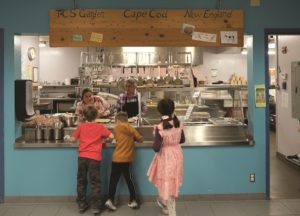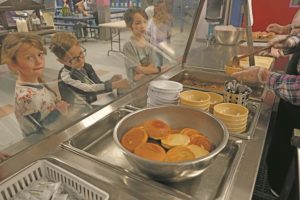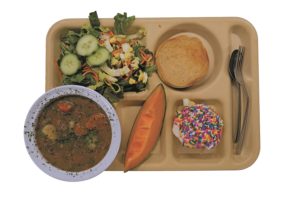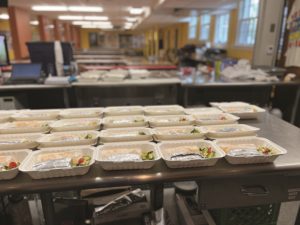At Truro Central School, the Menu Includes Local Choices
TRURO — On a rainy April day at the Truro Central School, Stephanie Rein, the school’s resident farmer, is outside with a few colleagues checking on the school garden. The soil is dormant and covered with salt hay, but soon Rein will begin spring planting, leading students in growing and harvesting vegetables. Rein, whose work is supported by Sustainable CAPE, an agricultural nonprofit, has learned that “if students grow it, they will eat it.”
Inside the school, Susie Roderick, the cafeteria manager, prepares the day’s hot meal, stirring a large pot of beef stew. “It’s chunks of beef, onions, garlic, carrots, potatoes, green beans, a little parsley, a little bit of basil, salt, and pepper,” Roderick says. On the adjacent burner she is cooking fish sourced from Cape Tip Seafood in preparation for Thursday’s fishcakes, for which she uses a recipe handed down by her mother.

A wooden sign hangs above the alcove where students are served, informing them of local ingredients in the meal. Today, it says, the parsley and potatoes were grown in the school garden, with the beef, carrots, and milk coming from elsewhere in New England. The parsley was harvested in the fall and then dehydrated and packaged, along with sage and other herbs, which are then used throughout the school year.
Roderick doesn’t find it hard to meet National School Lunch Program nutrition guidelines. “You have to offer five things every day: a grain, a fruit, a vegetable, milk, and a protein,” she says, but those rules have evolved so there is less waste — students can choose just three of the five items.
From a budget point of view, the government’s support for universal free lunches, instituted during the pandemic, will end on June 30. At that point, Truro will go back to applying for reimbursements under the USDA’s Community Eligibility Provision, by which schools where 40 percent of students are categorically eligible for free meals offer free lunches to all students, according to Heather Harper, who, among other jobs, is an administrator of the school’s finances.
In addition, Principal Patrick Riley says, Truro’s lunch program is self-sustaining, with staff paid out of the school budget so that lunch reimbursements go directly to food costs. Truro has its own self-contained school district, and Rein points out that means the school has the autonomy to collaborate with local producers in planning and budgeting for meals.
The kindergartners and third-graders arrive for lunch at 11 a.m., and most of the students opt for the day’s other options: sunbutter and jelly sandwiches, yogurt parfaits with granola and berries, or a bagel and cream cheese.

Getting them to try different things is a challenge, Roderick says. “We have beef stew today, but parfaits beat it,” she admits.
“There’s a lot of explaining what it is,” Michelle Mucic, the cafeteria assistant, adds. “If they don’t eat it at home, they don’t know what it is.”
The next group of students to arrive in the lunchroom are more enthusiastic about the day’s meal. At a table of second-graders, Albany Waite and Ella Rome are both eating the stew. “It’s rare to have beef stew at lunch,” Rome says. “It’s really good.”
When asked about her favorite school lunch, Waite replies, “Well, technically I love everything.”
“She’s a really good eater,” Rome interjects. Their classmate Mila Stojiljkovic chose the sunbutter sandwich, but she took a small bowl of stew, because sampling is encouraged by the cafeteria staff.
“I never tried beef stew. It tastes good,” she says as she scrapes her bowl clean.

For four dollars, the cost of a teacher’s lunch, I was able to taste the stew myself, which came with a slice of cantaloupe, a toasted hamburger bun, free rein at the salad bar, and a vanilla cupcake topped with rainbow sprinkles (or “jimmies” as they are called here). The beef was outstanding, bought through the food giant Sysco, but chosen by Roderick from a family farm in Maine where they produce hormone-free beef. It was tender and flavorful, falling apart at the touch of a fork. The vegetables were plentiful, though a little soft for my taste, and the overall flavor was mild, purposefully lacking any kick or spice to which children would likely object.
As the gardening season progresses, the menu shifts. “Whatever they bring us, we find something to do with it,” Roderick says.
“We helped grow purple potatoes and got to pull them up,” Rome says. “It was so fun to grow potatoes.”
Growing great vegetables is only half the battle, though. “My favorite foods are grilled cheese, pizza on Friday, and pasta,” Rome says, echoing the preferences of her classmates. Step by step, Roderick, Rein, and a team of others are doing the work of shifting attitudes and experiences of food at Truro Central School. —Abraham Storer
Some Hope for Healthier Lunch Options at Nauset Schools
NAUSET — Siblings Wila, Cove, and Jacob Parkington have differing opinions about the lunch at Wellfleet Elementary School.
While first-grader Wila loves the school’s Pizza Fridays and likes to “try the other stuff,” her older brothers have asked their mom to pack their lunches. Third-grader Cove explains that his sister likes the school food because “she has a lot of sweet tooths.”
“I don’t like the taste of the pizza, nachos, chicken nuggets, unhealthy yogurt that comes with chocolate dip, cookies, and strawberries,” Cove says. “It’s unhealthy and it hurts my tummy.”
Fifth-grader Jacob describes the food at school as “watery,” whereas lunches from home (typically a sandwich, salad, and a pickle) have “lettuce and meat and bread and cheese.” His mother, he said, also packs the “healthy yogurt” (without the cookies and chocolate) and “healthy salad” (with fresh carrots).
Administrators at both the Wellfleet and Eastham elementary schools declined to allow reporters to observe the school cafeterias at lunch time.
The schools’ monthly lunch menu can be found on the district’s website. The menus, with nutritional information listed, are put together by Nauset School District Food Director Susan Murray, who works with a food manager at each school. She’s been the food director in the district for 10 years.
On Thursday, May 12, elementary school students at the two schools were offered a meatball sandwich, steamed carrots, oven-baked crinkle fries, assorted chilled canned fruit or fresh fruit, and assorted flavored and plain milk. Murray said the menus are made in accordance with USDA standards, whereby everything from calorie counts to required servings of grains and vegetables are regulated. Sometimes the menus will shift slightly, depending on what went well or what’s in stock, Murray said. While she doesn’t like to repeat too many meals in the same month, “Taco Tuesday” is standard and Friday is pizza day.
The food comes from the government and a broadline (high-volume and lower-priced) food service that the district invites bids for. For the past several years, the schools have gone with Thurston Foods, a Connecticut company, Murray said. Thurston has been winning the contract “because they’re the lowest price around and they have a lot of the school foods that are highly regulated,” said Murray.
The Parkington siblings’ mother, Nicole, says she understands that Truro and Provincetown are different, but “Wellfleet is part of the Nauset system that needs to follow Nauset rules.” She gets up early to make her kids breakfast and pack lunches, but she knows that not every parent’s schedule allows for that. If there were a way to implement healthier options for school lunches, she thinks parents and students would rally behind the effort.
Wellfleet Elementary School parent and certified integrative nutrition health coach Jennifer D’Aponte said many food decisions and habits start in childhood. She says she wishes Wellfleet could incorporate more fresh, local foods in school lunches.
“There are ways we can incorporate everyday healthy living into a student’s education,” she said. “It’s shocking to me we serve frozen fish sticks at schools on Cape Cod.”
She argues that, while the changing the system might seem complicated, there are simple solutions in plain sight. “Why can’t we start with a garden like they have in Truro?” she asks. —Michela Chesin
New Foods Keep Provincetown Students Engaged
PROVINCETOWN — “Hey, Brandon! Hi, Alicia!” Chef Andrew Bernard calls out to students walking by the International Baccalaureate school kitchen.
Bernard (or Chef Andrew, as he is known by students), recognizes and greets all his diners, even with their masks on, by name.
“Chef Andrew, can we have more pizza?” a girl asks.

His cauliflower thin-crust barbeque chicken pizza is justifiably popular. The slice he served a reporter was nicely accompanied by a fresh pineapple skewer, wrapped in wax paper.
“I went to culinary school, and I never imagined myself someplace like here,” he says. “But I feel like I’ve hit the lottery.”
Chef Andrew, whose husband teaches third grade at the school, provides sustenance for both students and teachers.
“Do you need a to-go box?” he asks a teacher as she walked in at the end of recess.
“I just want something with caffeine,” she responds.
Because of Covid restrictions, students pick up stacks of boxed lunches in bins and bring them to their classrooms, where they eat during their 50-minute lunch and recess period. Last Friday, Bernard and Sous Chef Margarita Millan cooked 145 meals. The Provincetown school system — its own small district, which Bernard says gives him flexibility when planning menus — hosts 151 students including those at the Early Learning Center. There are just a handful of students at the Provincetown Schools who don’t eat school lunch — a choice Bernard attributes to pickiness.
“Peanut butter and jelly sandwiches are popular when students arrive in kindergarten,” Bernard said. “But by first grade, most students get the hot lunch.”
Chef Andrew’s personal favorite is a chicken satay with “peanut-free peanut sauce.” He orders most of his ingredients from Gordon Foods and U.S. Foods, he says, but also sources locally from J&E Produce.
The USDA’s Community Eligibility Provision funds free meals for all students in schools where 40 percent or more of the students are eligible for free lunches based on their participation in other means-tested programs, such as the Supplemental Nutrition Assistance Program (SNAP) and Temporary Assistance for Needy Families (TANF) — which is the case in Provincetown.
“In my six years here, I’ve never charged a student for lunch,” Bernard said. “I don’t know how I’d do that.”
“I like pizza,” one student reflected.
“No — popcorn chicken!” his friend said.
“That one’s popular,” Bernard said, “but I only serve it every other month because I want them to miss it. To keep them engaged.” —Thomas Lyons
